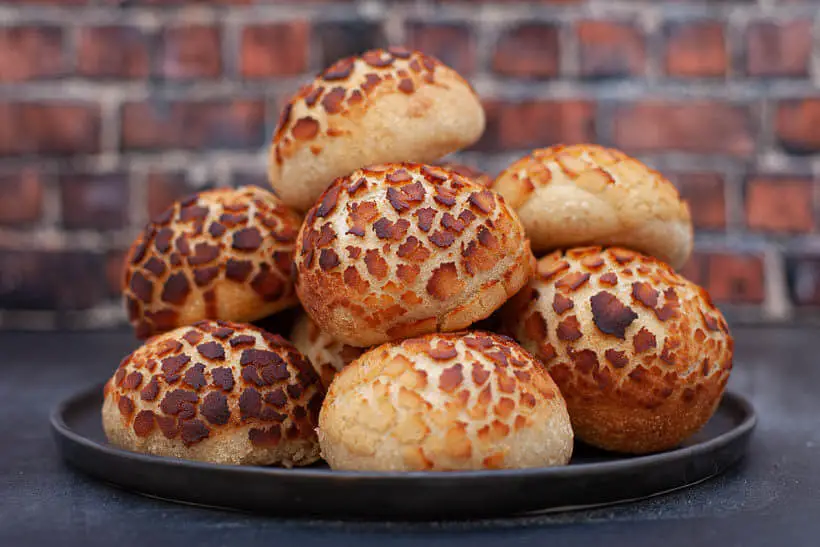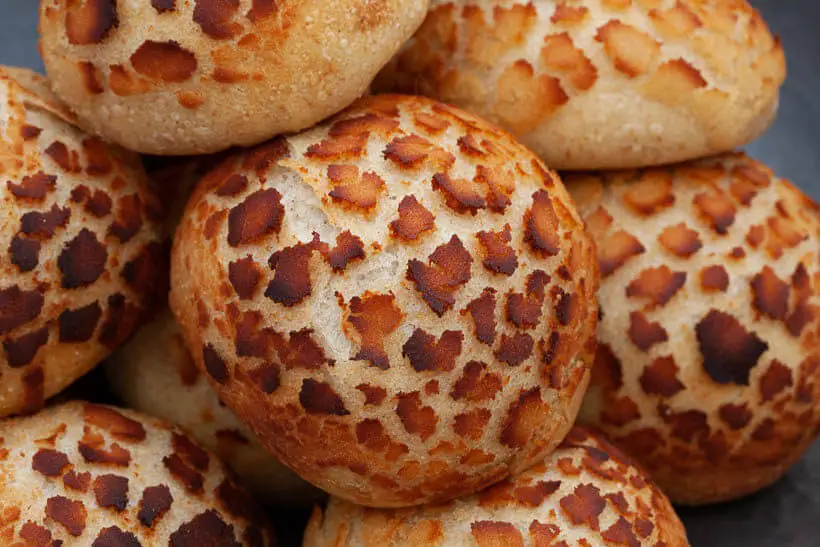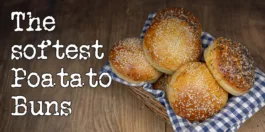What makes food interesting? For me a big part of it is contrast. Sweet vs. sour, creamy vs. bitter, crunchy vs. soft, The last one is the one that defines these rolls. This is my recipe for sourdough tiger bread rolls.
The tiger bread rolls are the softest, fluffiest buns you’ve ever had, with an extremely crunchy and dark caramelized topping made from yeast, rice flour, and toasted sesame oil, which gives it an incredible aroma.

This dough can absolutely be used for larger sandwich rolls or an entire bread. It’s all up to you.
If you are just here for the recipe, press the button below to be automagically transported there:
Jump to RecipeThe history of tiger bread
Tiger bread originates from the Netherlands where it’s known as tijgerbrood (tiger bread) or tijgerbol (tiger bun).
I haven’t really been able to find many actual sources of the history, but a lot of conjecture. According to Johnathan Law on Quora, it may have been inspired by or originated from an Asian bun called “Bo Lua Bao”, which is a pineapple bun.
The look of them is quite similar, but not the taste though. His hypothesis is that an Asian baker tried to imitate a streusel topping found in dutch bread (found in Asia because of Dutch colonization) but didn’t have the right ingredients, hence invented the tiger bread.
This tiger bread has been known commercially in the Netherlands since the early 1900s but made its way to the Bay Area of San Francisco. It probably came with Dutch immigrants which also gave it its name ‘Dutch Crunch’.

Hyperbowler on Chow Hound looked at when the term ‘Dutch Crunch’ was used in national newspapers in the United States. It seems it was first mentioned around 1940, but it seems that the Dutch Crunch came from sesame seeds and not the rice flour topping used later on. Possibly around 1950, the rice flour topping was used.
The bread was described as “A traditional, round, unsliced, Sweet French Load (loaf?) to which, after rising and before baking, the old dutch master bakers of the Netherlands, started the custom of polishing the top of the dough with a glaze which pops into a Golden Dutch Crunch up baking.”
No matter the origins, it’s very delicious.
The formula in this sourdough tiger bread rolls recipe
If you don’t already have a sourdough starter, you can follow my guide here.
The dough recipe itself is enriched dough with milk and egg. The hydration sits at a comfortable 66%, which means that the dough is tacky, but not sticky, making it easy to handle and shape.
For a bit more delicious taste I’ve added whole grain spelt flour. If you want a totally classic tiger bread roll, you can substitute it for bread flour, or you can use another whole grain if you can’t find spelt where you live.
| Weight | Ingredient | Baker's Percentage |
|---|---|---|
| 560g | bread flour | 85.5% |
| 95g | whole grain spelt flour | 14.5% |
| 410g | milk | 62.6% |
| 15g | salt | 2.3% |
| 25g | egg | 3.8% |
| 150g | starter (100% hydration) | 22.9% |
If you want to play around with the formula, change hydration or scale the recipe, you can find the formula in my bread calculator here.
The baking of this sourdough tiger bread rolls recipe
As with most of my baking, these rolls are baked with steam, for great oven spring. The temperature is a lot lower than what I use for my sourdough bread. I bake it at 200°C/392°F.

I am not interested in creating a crunchy crust like I normally will do with sourdough bread. I want the bun to be very soft, both inside and out, so that’s why I am using the lower temperature. The topping will take care of the crunch.
If you were to bake these buns without the topping, they’d make an excellent soft bun.
Alternate divisions of the dough
If you want, you can bake both rolls, burger buns, sandwich rolls, small bread, or large bread using this dough. Here are my suggested divisions and baking times:
| Divisions | Weight | Baking time | |
|---|---|---|---|
| Rolls | 12 | 100g | 20 minutes |
| Burger buns | 8 | 150g | 25 minutes |
| Sandwich rolls | 4 | 300g | 30 minutes |
| Small bread | 2 | 600g | 40 minutes |
| Large bread | 1 | 1200g | 50 minutes |
The larger the bread you make, the bigger the chance of scorching the top. My suggestion is that you cover it with a piece of aluminum foil once the desired caramelization has been reached. That should prevent the top from scorching.
Conclusion on this sourdough tiger bread rolls recipe
These rolls are a delight. They are great on their own as a snack. The savory topping works with many types of meat and cheeses.
The bun itself is the softest and fluffiest bun that I’ve ever tried with an airy texture and a lot of holes. The topping is super crunchy and has a delicious aroma from the toasted sesame seed oil.
When you bite into the bun, the topping shatters and the crunch is so satisfying.
Listen to the recording of me biting into the bun in the B-roll in my video. I said God damn, God damn.
Please share on social media to let try this sourdough tiger bread rolls recipe
This is my recipe for sourdough tiger bread rolls recipe. I hope you will try to make it. If you make this recipe and post it to Instagram, please tag med as @foodgeek.dk so I can see it. That will make me very happy.

Tiger Bread Rolls
Ingredients
Dough
- 560 g bread flour
- 95 g spelt flour can be substituted with another whole grain or freshly milled flour
- 410 g milk
- 1 egg
- 150 g starter fed and grown to its peak
- 15 g salt
Topping
- 7 g active dry yeast 1 packet
- 100 g lukewarm water
- 105 g white rice flour
- 15 g brown sugar
- 14 g neutral oil
- 14 g toasted sesame oil
- 4 g salt
Instructions
Mix the dough
- Mix 1 egg into 410g milk using a whisk.
- Add 560g bread flour, 95g spelt flour and 15g salt. Give it a mix with your hand so that it's good and well mixed.
- Pour in the milk mixture and add 150g starter on top.
- Mix the dough so that all flour is completely hydrated and let the dough rest for 30 minutes.
Bulk fermentation
- Perform four sets of stretch and folds spaced out by 30 minutes.
- Let the dough rise until it's increased about 50%, then place the dough in the fridge until the following day. It took about 5 hours for me from the first stretch and fold.
Dividing and shaping the dough – next day
- Remove the dough from the fridge and divide it into twelve equally sized pieces at around 100 grams of dough.
- Shape each dough piece to a ball by pushing the dough up into the middle of the ball, then turn the ball about 20° and repeat until you have a taut surface.
- Place the dough balls on a baking sheet lined with parchment paper and let them rest for fifteen minutes.
- Then do a final shape of each roll by putting it onto your unfloured counter, putting your hand over the top of the ball like a claw, and moving it in circles, making it perfectly round.
- Place back on the cookie sheet and let them rise for about one and a half hours covered with a damp tea towel.
Make the topping
- Preheat your oven to 200°C/390°F/Gas mark 6 (use fan-assist if you have it) with an empty pan on the bottom.
- Make the topping by placing 7g active dry yeast, 100g lukewarm water, 105g rice flour, 15g brown sugar, 14g neutral oil, 14g toasted sesame oil and 4g salt in a bowl. Mix with a whisk to combine.
- The mixture must be spreadable, so adjust using a small amount of water or rice flour to make it a thick, spreadable consistency if it's not already at that stage.
- Put an equal amount of topping on each bun and spread it using a pastry brush.
Bake the rolls
- When the oven is hot, boil a kettle of water and pour it into the pan, and put the baking sheet in the oven on the middle rack. Close the oven and let it bake for 20 minutes.
- Check the rolls after 20 minutes; if you think they need more time, then bake for longer.
- If you like to check the internal temperature, it should be about 98°C/208°F.











I’m wondering what you might suggest as an egg and milk replacer as I am vegan?
For milk you can use any vegan milk you can fine.
For the egg I’d recommend you find the one that suits your tastes here: https://www.healthline.com/nutrition/egg-substitutes
Thanks a lot for you effort, have learnt a lot from your videos. Can I substitute olive oil for flavour instead of toasted sesame oil since I am not about to find it now In the market?
You can. It’s just a very different taste profile, but it sounds delicious 🙂
hello, I just wanted to ask how you would go about shaping the dough if you chose to make a loaf as opposed to rolls. PS, I loved the video, it made this recipe seem much less daunting!
I’d shape it like I do with my https://foodgeek.dk/en/blueberry-swirl-sourdough-brioche-bread-recipe/ and bake it in a pan 🙂
For topping, can I store the leftover in the fridge for next time ? I would only use 350g bread flour for this bread, but want to follow the exact ingredients of your topping. I like that you use oil instead of butter, especially sesame oil, it does bring up the flavor. Thank you.
I wouldn’t keep the topping unless you are baking close to when you made it. Maybe a few days in the fridge. 🙂
Sune, so glad to have found your website! Tried these today, they cooked fine but the crust split before the rice topping formed, any ideas what this may have happened?
The dough was not fermented long enough 🙂
Hey Sune, my journey with sourdough under the guidance of you Master going very smooth! I really love your passion and understanding about baking, specially in sourdough!!! I am pretty excited to make your tiger bun roll recipe using sourdough but I am allergic to eggs,what should I use to replace egg in this recipe.
Thank you.God bless you…
I want to make this recipe, but I’m vegan. Do you think organic Soy Milk would have to be scalded as well?
How long should the bakes rolls rest to cool before eating?
Just pulled these out of the oven! OMG!!!!! They look and smell divine! Thanks for such a easy and concise recipe!!! 🙏🙏🙏
What purpose are the eggs in here for? is it binding, leavening or flavour? This will help me work out what to substitute it for? Thanks in advance
Can I shape the dough straight after the bulk and leave them in the fridge over night, then just prove them for the hour and half in the morning?
Why do you heat the milk and the cool it? Why not just use room temperature milk?
Well, conventional wisdom says that milk can prevent certain things to happen. Like gluten development.
But this only goes for unpasteurized milk, so just skip that step and use milk directly.
Topping not cracking? 20-25mins at 425*
Interesting that you reroll the rolls a second time. Does that help give them a rounder shape and not flatten out? I have been baking sourdough sandwich buns for several years and have never seen that suggestion before. I normally use a bun pan for the rolls, but with the topping I can’t do that.
It helps them retain their shape better, but depending on the flour you use, it might not be as important. I try to cover all the bases though 🙂
There is no recipe on the internet for a Sourdough Dutch crunch LOAF or Boule so I used your recipe and baked the boule at 450oF 20 m in and then reduced the temp to 400oF and removed the lid for another 25 minutes. Perfect! The extra steps with the milk and levain were worth the effort. Thank you! Denise
Love this recipe! I have not had this bread since I was a little girl in Minnesota. There was a Dutch bakery down the street from our home and they had the most delicious bread, this is the closest I have found to that bread I remember – and I am 64! Thanks for posting. I am making this recipe for guests tonight. They turned out beautifully!
Thank you. That’s wonderful to hear 🙂